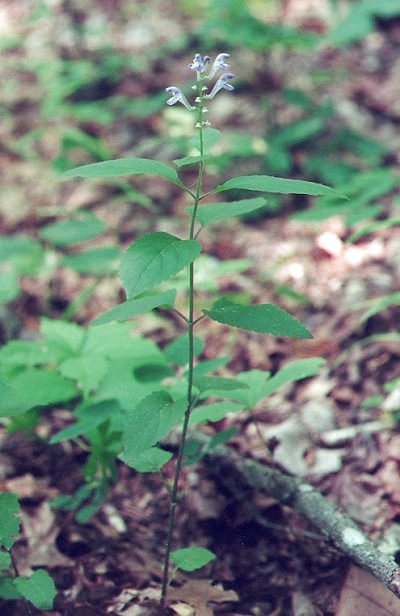Scutellaria elliptica Spreng.
Hairy Skullcap

Native
CC = 7
CW = 5
MOC = 25
© DETenaglia
Scutellaria elliptica Spreng.Hairy Skullcap | |
 |
Native CC = 7 CW = 5 MOC = 25 |
© DETenaglia |
|
Family - Lamiaceae Stems - Single from thickened roots, rhizomatous, 4-angled, purplish(at least at base), tomentoulose, to 1m tall, erect, herbaceous. Pith white. Leaves - Opposite, decussate, petiolate. Petioles tomentoulose, (at least the lowest with glandular hairs also), to +/-1.5cm long, with an adaxial groove. Blades ovate to ovate-elliptic, crenate-serrate, truncate to abruptly cuneate at base, acute, to +/-9cm long, +/-4.5cm broad, mostly glabrous and deep green above, pubescent and silvery-green abaxially, sparse glandular punctate on both surfaces. Margins ciliate (ciliolate).
Inflorescence - Terminal bracteate raceme to +/-7cm long(tall). Axis tomentoulose. Pedicels glandular tomentose, 2-3mm long, purplish, with two minute, (to 1mm long and linear), bracts attached near base. Bracts subtending pedicels foliaceous but reduced, to 1cm long.
Flowers - Corolla purplish, bilabiate, to 2.5cm long, glandular pubescent externally, sparse glandular pubescent internally. Upper lip 3-lobed. Central lobe galeate, 5-6mm long. Lateral lobes rounded and much shorter than the central lobe. Lower lip single-lobed, purple, 7-8mm long, 8mm broad, often folded downward, with a white splotch near the base internally. Stamens 4, adnate near the middle of the corolla tube, included, didynamous. Filaments white, mostly glabrous but with some glandular hairs. Anthers 1.5mm long, pubescent, yellowish-purple. Style inserted between the stamens, white, glabrous, to 2.4cm long. Ovary superior, 4-lobed, with two lobes raised slightly higher than the other two, to 1.5mm tall. Lobes and base of ovary yellowish, white whitish glands. Often only one lobe expanding and forming a tuberculate nutlet in fruit. Calyx light green, tomentose and glandular pubescent, accrescent, to 4mm long in flower, lobes converging and enclosing the seeds in fruit. Dorsal protuberance 2.2mm broad, -1mm tall (in flower).
Flowering - May - July. Habitat - Dry rocky woods, bluffs, wooded slopes. Origin - Native to U.S. Other info. - This striking species is found in the Ozark region of Missouri. This species resembles another, S. incana Biehler, but the former has glandular pubescence on the calyx and the lower petioles, S. incana does not. Other than those characteristics, the two species are nearly identical. All of the members of this genus found in Missouri are worthy of cultivation and grow well from seed. Although the genus Scutellaria belongs to the same family as the mints, none of the plants have a minty fragrance. Photographs taken at the Current River Conservation Area, Reynolds County, MO., 6-20-01, and in the Ozark Scenic Riverways, Shannon County, MO., 5-30-03. |